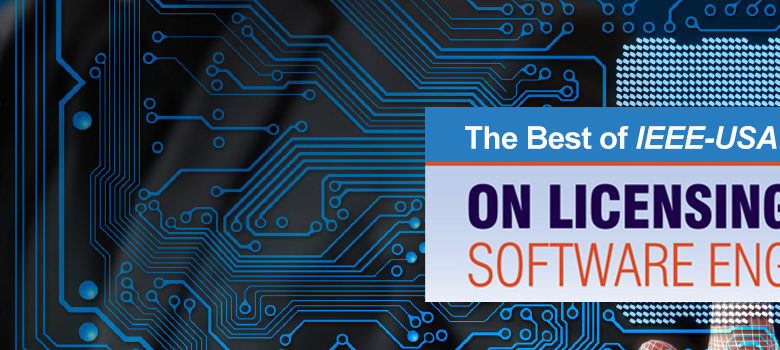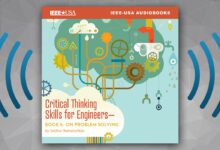
Hotly debated but plainly inevitable, the topic of licensing software engineers in the United States is examined in a new e-book, The Best of IEEE-USA InSight: On Licensing Software Engineers. It is a compilation of 10 useful articles that have appeared within the last few years.
Today, with more than 40 states and U.S. jurisdictions supporting the licensing of software engineers-and more states expected to jump on board-this e-book offers timely, relevant information for software engineers at all phases of their careers. The articles recount the history of the licensure movement, make the case for licensure, review and refute opponents’ major arguments; and finally, tell how to achieve licensure-should an individual choose to do so.
The volume was compiled by Philip A. Laplante, CSDP, P.E., Ph.D., who is chair of the Software Engineering Licensure Examination Development Committee, and a member of IEEE-USA’s Licensure and Registration Committee. An expert on safety critical systems, he and Mitchell A. Thornton, who is vice chair of the IEEE-USA Licensure and Legislation Committee, wrote most of the articles.
The Best of IEEE-USA InSight: On Licensing Software Engineers is available at https://ieeeusa.org/product/the-best-of-ieee-usa-insight-on-licensing-software-engineers/. The member price is $7.99; non-members can purchase it for $9.99.
Laplante has divided the e-book into three sections: the case for licensing software engineers, including objections and rebuttals to such licensure; requirements for obtaining licensure; and how qualified software engineers can go about obtaining licensure. The last section includes information about the IEEE-USA study guide for the exam, and an article aimed at computer engineering students. It explains the importance of taking the Fundamentals of Engineering (F.E.) examination in their senior year, and how professors can help them.
In the first section, Thornton explains the differences between licensure and certification. He emphasizes that most states license activities which could result in damage to public health, safety, or welfare-if practiced by an individual who has not demonstrated minimal competence. In another article, Laplante and Thornton make the case that state licensure provides a consistent set of criteria for judging the minimum competency of a software engineer. “The public is protected because only competent engineers are permitted to work on systems that affect health, safety and welfare,” they write.
“It is likely that the main types of systems that will require a professional engineer are embedded systems,” they continue. They cite a broad range of applications in transportation, medicine and process control, where a licensed software engineer would need to write the critical part of the system
The second section of the compilation delineates the path to licensure, and examines the software engineering exam principles and practices. Thornton describes how the idea for the licensing exam originated with the five organizations who partnered in 2009 to form the Software Engineering Consortium. They were the IEEE-USA Licensure and Registration Committee, the IEEE Computer Society, the National Council of Examiners for Engineering and Surveying (NCEES), the National Society of Professional Engineers, and the Texas Board of Professional Engineers. The exam tests for basic knowledge, not mastery of subject matter. Applicants must have four to six years of experience as a software engineering practitioner.
Also in the second section, David L. Whitman, Ph.D., P.E., discusses new specifications that took effect in January 2014 for the Fundamentals of Engineering (F.E.) Examination. Whitman, who heads the NCEES’ Committee on Examinations for Professional Engineers, explains how the former “common breadth” portion of the exam had to be changed to reflect the nationwide move toward less uniformity in core engineering curricula. This change required major alterations in the F.E. exam to preserve its relevance to professional licensure.
In the third section, Thornton responds to professional engineers who want to understand how licensure will benefit them. He says that while many engineers work for companies, and are usually protected by “industry exemption” clauses, many other engineers will need to be licensed-if they want to work as a consultant, or start their own engineering company. “Licensure gives you the privilege to offer engineering services to the public,” he writes, “and under most U.S. state laws, it’s illegal to start your own engineering business without being licensed, or at least having a company officer in charge of engineering who is licensed.”
Elsewhere in this section, Laplante writes about the IEEE-USA study guide developed to help prepare for the Principles & Practice of Software Engineering Examination. He points out the most daunting obstacle to licensure may actually be the Fundamental of Engineering (F.E.) Examination-and he suggests steps to ensure success.
“Being a licensed professional software engineer is an important credential, and even if not required for the work you do, can distinguish you from other professionals and unlock job opportunities,” he says.
Helen Horwitz is an award-winning freelance writer who lives in Albuquerque, N.M. She was with IEEE from 1991 through 2011, the first nine as Staff Director, IEEE Corporate Communications.






